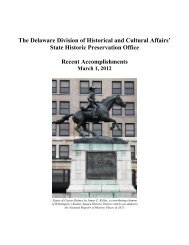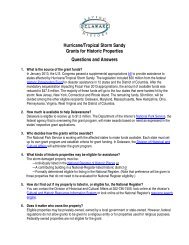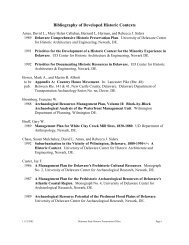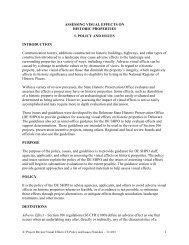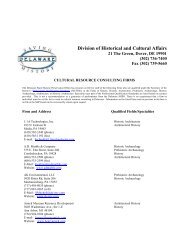Report of the Archaeological Investigations of the New Castle Court ...
Report of the Archaeological Investigations of the New Castle Court ...
Report of the Archaeological Investigations of the New Castle Court ...
Create successful ePaper yourself
Turn your PDF publications into a flip-book with our unique Google optimized e-Paper software.
NEW CASTLE COURT HOUSE PLAZA<br />
NEW CASTLE, DELAWARE<br />
4.0 ARTIFACT ANALYSIS<br />
by <strong>the</strong> American War for Independence (Pendery 1980:28-32). The archeological deposits at<br />
Puddle Dock were reported to date to circa 1710. The presence <strong>of</strong> <strong>the</strong> coral was mentioned but<br />
unexplained; at <strong>the</strong> time, however, it was noted that “it is usually found in excavations around old<br />
wharves” (Speare 1969).<br />
4.4.3 DUTCH YELLOW BRICKS<br />
A small quantity <strong>of</strong> yellow brick fragments (n=18) was recovered from eleven contexts at <strong>the</strong><br />
<strong>Court</strong> House excavations. The majority <strong>of</strong> <strong>the</strong> contexts (10 <strong>of</strong> 11) were located on <strong>the</strong> east plaza,<br />
and three were associated with Feature 20 (Plate 23). Of <strong>the</strong> measurable bricks in <strong>the</strong> assemblage,<br />
eight fragments were complete enough to provide information on brick dimensions, and six <strong>of</strong><br />
<strong>the</strong>se fragments were found in Feature 20.<br />
The bricks recovered from Feature 20 appear to be <strong>of</strong> a small brick type <strong>of</strong> Dutch origin referred<br />
to as drielingen. This type <strong>of</strong> brick was specified in an early seventeenth-century law as a<br />
standard size for buildings in Amsterdam, and drielingen were soon used in o<strong>the</strong>r parts <strong>of</strong> <strong>the</strong><br />
Ne<strong>the</strong>rlands and <strong>New</strong> Ne<strong>the</strong>rlands (Blackburn and Piwonka 1988:127). Standardized<br />
measurements for drielingen were 6 x 3 x 1 inches (current measure) (Blackburn and Piwonka<br />
1988: 127). The yellow brick from <strong>the</strong> <strong>Court</strong> House excavations are generally a 2.5Y 8/4 hue and<br />
chroma, using <strong>the</strong> Munsell Soil Color Chart. O<strong>the</strong>r categories <strong>of</strong> Dutch yellow brick, such as <strong>the</strong><br />
larger moppen and Vecht or Utrecht-sized bricks were not present in <strong>the</strong> assemblage (Blackburn<br />
and Piwonka 1988:127).<br />
Archeologist Richard Viet reports that drielingen are <strong>the</strong> most frequently reported type <strong>of</strong> Dutch<br />
brick found on seventeenth-century archeological sites in Delaware, and have also been reported<br />
in Maryland, Pennsylvania, <strong>New</strong> York, Virginia, and <strong>the</strong> Caribbean (Viet 2000:70). The brick<br />
was relatively water resistant, resists wear and frost damage, and allows mortar to cure more<br />
fully. Overall, yellow brick was an excellent brick for exterior construction <strong>of</strong> building facades,<br />
roadways, and footpaths (Blackburn and Piwonka 1988; Meeske 1998:212-214).<br />
4.4.4 GUN FLINTS/FLINT FRAGMENTS<br />
A small number <strong>of</strong> European flint flakes (n=33), European gun flints (n=2), and one locally<br />
reworked flint strike-a-light were recovered from <strong>the</strong> archeological field investigations.<br />
Approximately 76 percent <strong>of</strong> <strong>the</strong> flint flakes were recovered ei<strong>the</strong>r from SU C (n=3), SU E (n=7),<br />
SU J (n=2), or Feature 20 (n=13). Two European flints (contexts 37 and 158) were recovered<br />
from SU E and a flint strike-a-light (context 43) was recovered from Feature 20. Each <strong>of</strong> <strong>the</strong><br />
following contexts yielded a single flint flake (SUs M and N; EU 4, Level 3A; cleanup <strong>of</strong> EU 8;<br />
Features 9 and 21) except for SU B, from which 2 flakes were recovered (Nöel Hume 1969:219-<br />
221).<br />
4.4.5 PREHISTORIC ASSEMBLAGE<br />
In <strong>the</strong> proposed Archeological Preservation Plan for <strong>New</strong> <strong>Castle</strong> Heite <strong>the</strong> area <strong>of</strong> <strong>the</strong> Market<br />
Square was identified as an area that had a high potential for Native American remains, since <strong>the</strong><br />
area was a topographic high point in <strong>the</strong> town, was a center <strong>of</strong> seventeenth-century life, and may<br />
have functioned as a rendezvous point for European traders and Native Americans (Heite and<br />
Heite 1989:39-41). Despite this recommendation <strong>the</strong> number <strong>of</strong> prehistoric artifacts (n=106)<br />
recovered from <strong>the</strong> deposits beneath <strong>the</strong> <strong>Court</strong> House plaza was a ra<strong>the</strong>r unexpected discovery.<br />
71





